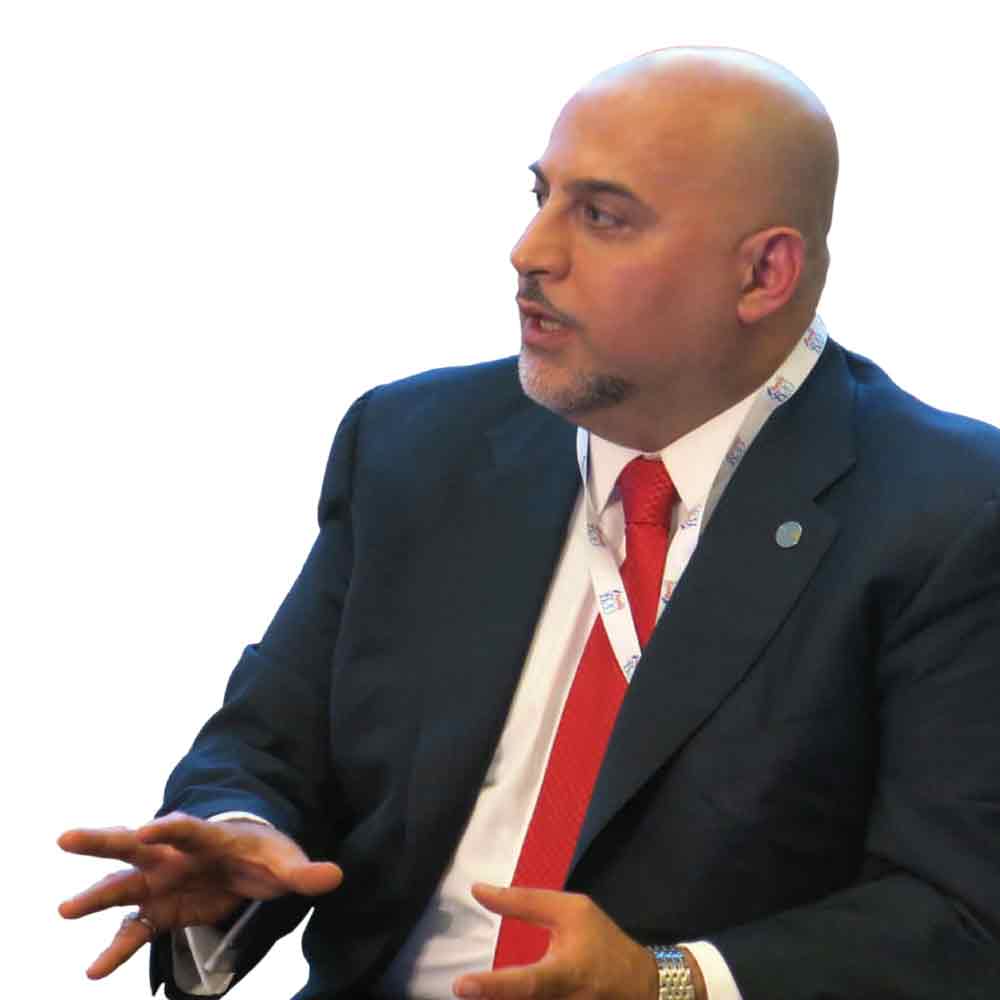Mr. Daniel Funes De Rioja, 2018 Argentina B20 Chairman and Captain Salloum, GCEL Co-Chairman discuss how in today’s digital era new technology can deliver inclusive economic growth in the G7 executive talk series.
In Today’s Digital Era – CAN NEW TECHNOLOGY DELIVER INCLUSIVE ECONOMIC GROWTH?
The Digital Economy is the Foundation to Build Renewed Trust
Since the Global Financial Crisis (GFC), trust between policy-makers and citizens has been diminishing, which raises questions about the effectiveness of G7 summits and similar forums.
QUESTION: What are your thoughts about the root cause of this discontent?
RESPONSE BY DANIEL FUNES DE RIOJA:
The GFC was the most challenging economic environment we experienced since the Great Depression. When they were confronted by difficult market forces, ruinous forces in some cases, policy-makers restored stability to financial markets. This certainly was the first priority, but they haven’t been able to deliver sustained and inclusive economic growth.
While our public-sector leaders have recommended a number of good policies, there is more work to be accomplished. To bridge the gap between policy-makers and citizens, leaders must implement new policies by combining the efforts of the global-economy stakeholders—policy-makers, people and trusted service-providers—under an Implementable Policy Formula (IPF). Movingforward with this mindset, stakeholders can work together and capitalize on what each one does best.
This IPF must be based on the following:
I. A Common Denominator Among Policies: It is essential to focus on consistent elements of tangible, measurable policies that quickly deliver positive effects to the real economy.
II. Validation and Definition from the Ground Level: There is a need for real-economy participants to define the digital tools they need to work effectively and to validate the benefits they will deliver.
III. Industry Capability and Commitment: Once the benefits are validated, we must secure industry resources for rapid implementation. With stakeholders using the IPF, we can turn our diminishing trust to hope, hope to confidence and confidence to reality.
Briefly recalling recent developments relating to the IPF, the 2016 China G20 Leader’s Communique set forth the Digital Economy Development and Cooperation Initiative as a key policy directive to reenergize the global economy. This followed the 2015 Turkey B20, where the Digital Economy was identified as a common denominator impacting 17 of 25 key policy recommendations. At the ground level, nearly 95% of G20 citizens involving 71 government ministries, industry associations and academia defined the digital tools they need to reach business excellence.
Now that citizens have defined the digital tools they need, the tech industry must come together to provide them so we all can close the gap between policy-makers’ intentions and citizens’ economic needs.
Let me add another couple clarifying points. It is important to be careful and holistic when we define the Digital Economy. We must also not lose focus as we consider where our efforts can deliver the greatest positive impact.
Some have defined the Digital Economy as robotics, artificial intelligence or the Internet of Things, which are product oriented solutions, versus a holistic solution that is more expansive and impactful. Policy-makers have voiced an urgent need for the Digital Economy to spur sustainable economic growth and create millions of jobs around the world. The citizens at the ground level have defined the digital tools they need to work effectively.
We must focus our efforts by applying the formidable power of the Digital Economy where it will have the greatest impact: the USD 140 trillion business-to-business (B2B) marketplace, which encompasses manufacturing, agriculture and services industries around the world.
QUESTION: Since the global economy is interconnected, how can the Digital Economy tools deliver a significant long-term economic impact?
RESPONSE BY DANIEL FUNES DE RIOJA:

First, we must pay special attention to the powerful demographic trends that have stalled traditional monetary, fiscal and trade policy efforts to revitalize the global economy. We must take a bold new approach to understand and address our economic challenges so we can deliver a large, long-term impact.
THE COST OF INFORMATION TECHNOLOGY MUST NOT HINDER ECONOMIC GROWTH
To look at the broader picture, the world is divided into three categories: high-income countries (HIC), mid-income countries (MIC) and low-income countries (LIC). In 1980, the HIC were 21% of the world’s population.
Today, it is 16%, and estimated to reach 11% by 2050. The MIC and LIC comprise 84% of the world’s population and are growing rapidly.
In the HIC, the population is aging, birth rates are low, salaries are high and production capacity exceeds demand. In the MIC and LIC, the population is young and growing, but personal incomes are at least 80% lower than the HIC. To address the foregoing, we know of the diverse, challenging realities that affect various countries; the HICcannot clone people and a number of them face challenges to open their borders wider.
The only viable option is to build the purchasing power of the MIC and LIC, creating vast new markets for HIC products and services.
The only viable option for the MIC and LIC is to establish efficient, transparent operations, which will attract foreign and domestic investments, increase buying power and improve citizens’ lives.
When we apply new Digital Economy tools to digitize trade activities, we will create greater efficiency and transparency, as well. This will reduce trade and operating costs and decrease the risk of doing business, which will attract substantial new investment, increase financing and insurance, as well as grow trade among nations and regions. This will build the purchasing power of the MIC and LIC, which will provide new demand to fill the HIC’s excess capacity.
This practical, viable plan delivers a multifaceted method of developing a larger global economy and providing greater prosperity.
I encourage the technology industry to unite and deploy new, innovative digital tools to heighten efficiency and transparency across the global B2B marketplace. Since SMEs represent up to 80% of employment in a sizeable percentage of countries, the cost and complexity of technology must not restrictits adoption. With the right Digital Economy tools, we can rebalance and grow the global economy and we can do this swiftly.
A DIGITAL ECONOMY PLATFORM CREATED BY ALL OF US – FOR ALL OF US
QUESTION: How much can we expect from traditional methods of stimulating national economies and what other efforts can deliver what we need?
RESPONSE BY CAPTAIN SAMUEL SALLOUM:

As the shadows of the GFC linger, economic growth is too often tepid and economic disparity fuels global tension. Protectionist measures continue to gain ground. Fears of another recession mount, even amid fresh memories from the last financial crisis.
Since the GFC, governments have supplied the biggest fiscal stimuli since the Great Depression, but economic weakness persists. Debt restructuring and financial engineering cannot address our economic malaise. Our world needs a substantive economic step forward, but it will not be delivered through traditional measures including fiscal, monetary and trade policies. Benefits from those tools have been exhausted.
The question remains: How can we foster economic growth that is global and sustainable? International experts believe that a fully developed Digital Economy is the way to take this step, but it remains elusive for one simple reason — it lacks the engine to power it.
The Internet delivers email and information, and it connects consumers with products, but it doesn’t drive the foundation of the world’s economy—the USD 140 trillion business-to-business (B2B) marketplace— which remains relatively old-fashioned and based on manual processes.
Trade, the core of the B2B marketplace, depends on four key pillars, Commerce, Finance, Insurance as well as Logistics, which is the weakest link because of its fragmentation and inadequate automation.
This problem is mainly due to the Logistics industry making vertical investments to enhance what is, in fact, a horizontal process. The fact that Logistics is global trade’s weakest link is a fundamental concern because it connects our world by shaping and steering the flow of goods.
Once we deliver efficiency to logistics using a Digital Economy Platform (DEP), we will increase operating efficiencies, which will decrease trade and operating costs. The DEP also provides dynamic, validated information needed to deliver greater efficiencies in the Commerce, Finance and Insurance industries.
OUR WORLD NEEDS A SUBSTANTIVE ECONOMIC STEP FORWARD, BUT IT WILL NOT BE DELIVERED THROUGH TRADITIONAL MEASURES
New digital tools for trade will also maximize the use of physical infrastructure and provide trade-data transparency to support investments and maximize their returns, which is in line with the G7 Ise-Shima Principles for Promoting Quality Infrastructure Investment.
Perhaps most importantly, moving forward in this direction will de-risk international trade and build the buying power in mid and low-income countries, which will create vast new markets for their high-income counterparts. In this way, we can rebalance the global economy and grow the economic pie instead of competing over the same one.
We can only achieve this by deploying new digital trade tools that will reduce excess trade costs, increase financing and investment, better connect buyers and sellers, and grow world trade.
Internationally, experts agree that by applying the Digital Economy to our global value chains, it can reduce annual domestic and international trade costs by USD 3.7 trillion, increase global trade by USD 7.7 trillion, increase global GDP by 17% and create more than 300 million jobs across the world by 2030.
QUESTION: What does a Digital Economy Platform look like and how can we work together rusing today’s technology to facilitate economic growth that is global and sustainable?
RESPONSE BY CAPTAIN SAMUEL SALLOUM:
Following more than 10 years of research & development, a multi-dimensional public private partnership of more than 150 governments through their pan-regional representatives, 26 NGOs/IGOs and the world’s leading tech firms have united under a call for action to deploy a Digital Economy Platform that captures high-quality Big Data to seamlessly unite e-Commerce, e-Finance, e-Insurance and e-Logistics, and achieve broader economic integration.
Since trade is of national-security importance to all nations, the Digital Economy Platform cannot be led by one organization, country or region. We all must be part of it. This understanding has been made clear through the real-economy participants at the ground level, who specified the digital tools they need. Their insights were collected through a diagnostic assessment of trade practices by more than 70 G20 government ministries, industry associations, academic institutions and private-sector experts.
Nearly 95% of the G20 citizens agreed on and defined the digital tools they need, making it clear that they want a Digital Economy Platform with four fundamental elements:
I. It must be owned, governed and deployed with involvement of the world’s public and private sectors to address potential geopolitical and monopolistic concerns.
II. The platform must be free of cost to the end user and sustainable through revenue from new e-Commerce, e-Finance and e-Insurance services.
III. The Platform must encompass new digital tools deployed by the world’s leading technology firms, 26 of which have signed strategic agreements as a first step for selection to deploy the Digital Economy Platform.
IV. It must include a global data security standard that provides a multi-layered mechanism to safeguard stakeholders’ privacy and information security. These elements support recent proposals by G20 leaders to build a global community with a shared future in cyberspace that promotes connectivity, with information infrastructure as the foundation for economic growth.mThis is how we can ensure that economic growth is shared by everyone.
WE CAN REBALANCE THE GLOBAL ECONOMY AND GROW THE ECONOMIC PIE INSTEAD OF CONTINUALLY COMPETING OVER THE SAME ONE.
